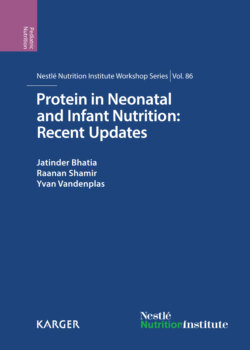Читать книгу Protein in Neonatal and Infant Nutrition: Recent Updates - Группа авторов - Страница 31
На сайте Литреса книга снята с продажи.
Partially Hydrolyzed Formulas
ОглавлениеCompared to eHFs, pHFs offer economical and taste advantages, and a theoretical benefit in inducing oral tolerance to the CMP as they still have a higher residual allergenicity.
A meta-analysis showed that a specific whey-based pHF (pHF-W) significantly reduces the incidence of atopic dermatitis approximately 44% [11 trials; summary relative risk (RR) estimate 0.56, 95% CI 0.4-0.77] up to 3 years of life in at-risk infants compared to CM-SF [28]. Another meta-analysis based on the use of the same pHF involving 3,284 participants (1,027 in pHF and 2,257 in control groups) reported reductions in all allergic diseases of 52% (5 RCTs: RR 0.48, 95% CI 0.23-1.00) at 3 and 6 months of age, 38% at 12 months (4 RCTs: RR 0.62, 95% CI 0.45-0.85; number needed to treat 12) and 58% at 30-36 months (1 RCT: RR 0.42, 95% CI 0.19-0.90) compared to SF [29]. For atopic dermatitis or atopic eczema (8 RCT), using a random effect model, the use of pHF compared with SF statistically significantly reduced the incidence of eczema at 1 year (4 RCTs: RR 0.68, 95% CI 0.48-0.98), but not at 4-6 months (5 RCTs), 2 years (3 RCTs) or 30-36 months (2 RCTs) [29]. However, many trials included in the analysis presented a lack of methodological rigor in sequence generation, allocation, blindness, definition of atopic manifestations, outcome data, intention-to-treat analysis, calculation of the sample size, selective reporting and other biases [29, 31].
A single-blind RCT, published after these meta-analyses, enrolling 620 high-risk infants before birth, found a higher incidence of allergic symptoms at 2 years in the ones fed with soy formula (44%) compared to a similar rate (37.7 vs. 37.3%) in pHF- and CM formula-fed participants. There was no difference in skin prick test reactivity or, at 6 and 7 years, in the rates of eczema, asthma or allergic rhinitis among the three groups [32]. However, different methodological issues have been raised that call for caution, including the unclear reason for publishing the results 15 years after collecting the data, outcome assessment through telephone interviews with parents and changing definitions of outcome indicators compared with previous publications on this cohort [33]. Moreover, the formulas were introduced after discontinuation of breastfeeding, determining a possibly delayed intervention and reduced clinical efficacy.
